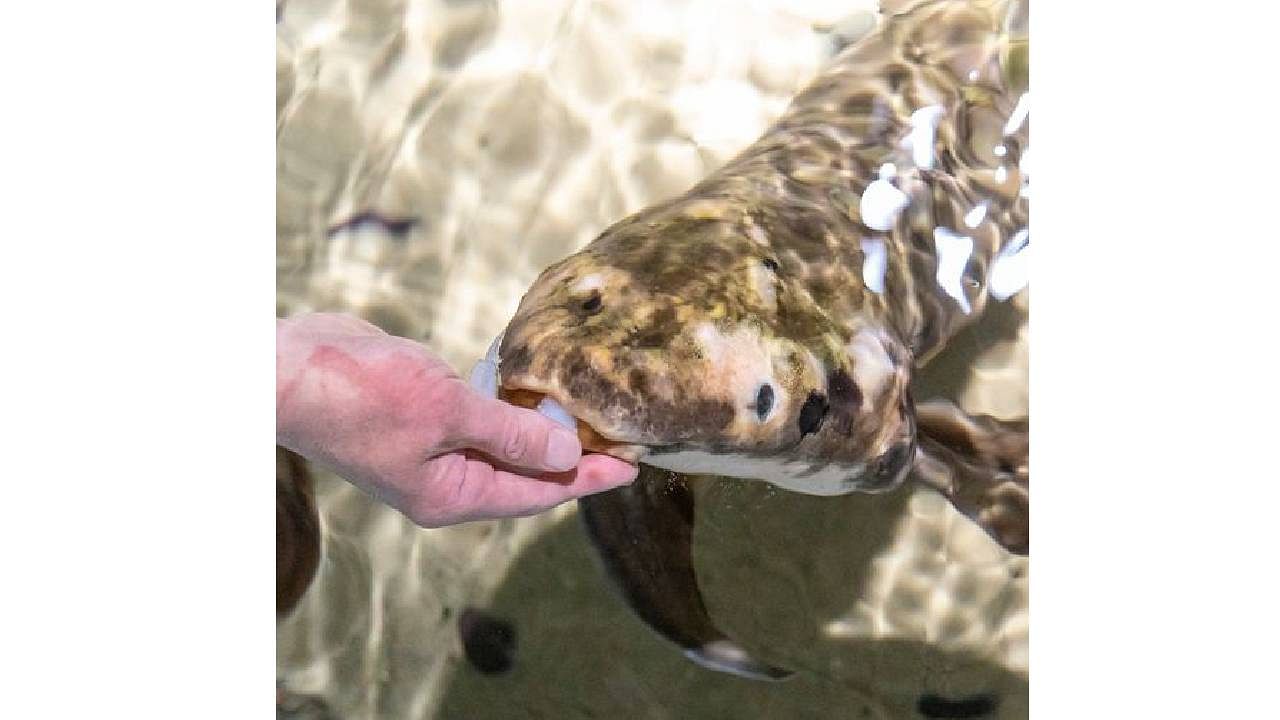
A photo of Methuselah, the oldest living aquarium Australian lungfish.
Credit: X/ @calacademy
In the fall of 1938, the Golden Gate Bridge had been open for a year, the United States was still recovering from the Great Depression and Franklin D Roosevelt was in his second term as president. World War II had yet to begin. And in the cargo hold of a steamship, a young lungfish arrived from Australia to a new home at an aquarium in San Francisco.
She’s still alive today.
In a delightful piece of California trivia, what is believed to be the world’s oldest fish in human care can be found in Golden Gate Park, at the Steinhart Aquarium of the California Academy of Sciences.
I recently met Methuselah, as the fish is known, and can attest that she’s a particularly charming celebrity.
With a torpedo-shaped body covered in mossy green scales, she glides through her tank at a glacial pace that seems only appropriate for her advanced age. She pokes her flattened snout out of the water when her caretaker offers prawns, earthworms or her favorite food, figs. She eats out of humans’ hands, and sometimes even enjoys a gentle belly rub or a tickle on her chin.
“She’s a pretty content, happy fish, I’m going to say,” said Brenda Melton, the aquarium’s director of animal care and well-being. “She’s been around a long time. She’s seen more than any of us at Steinhart Aquarium. We’re lucky to have her.”
The staff knew the date when Methuselah arrived at the aquarium, so it’s been clear for years that she was at least an octogenarian. And she assumed the unofficial title of world’s oldest aquarium fish in 2017 when Granddad, another Australian lungfish, died at the Shedd Aquarium in Chicago at age 95.
But it’s only recently that a scientific analysis of Methuselah’s full age has been performed, because traditional methods for doing that are invasive and for the most part feasible only post-mortem. Using a new DNA-dating technique, though, Australian scientists tested a tiny sample of one of Methuselah’s fins and concluded that she’s probably about 92, with an upper estimate of 101.
The news is especially meaningful for its timing: This month, the aquarium turns 100, so its most beloved fish might well “be celebrating her centennial birthday along with Steinhart,” Melton said.
The Australian scientists, who plan to publish their full findings later this year, studied samples from 30 other lungfish living at institutions in the United States and Australia. Steinhart’s two other lungfish were found to be about 54 and 50 years old.
“I don’t know that we truly know how long they can live,” Kylie Lev, a curator at the aquarium, said as we peered through the glass, watching the younger two lungfish flap their fins as they swam through their tank. Bowhead whales, rougheye rockfish and some giant tortoises can live for roughly 200 years, but even so, lungfish probably rank among the longest-living species in the world.
And they’re unusual. They are native to only a handful of slow-moving rivers in Queensland and, as their name suggests, have a lung that allows them to supplement the oxygen they get through their gills.
Lungfish are primitive creatures that have been around for 380 million years and are the closest living relatives to the first fishes that crawled out of the sea. In other words, lungfish represent the evolutionary link between fish and amphibians. Steinhart staff members call them living fossils.
Methuselah may not be quite as old as the biblical figure Methuselah — Noah’s grandfather, who lived for 969 years — but in many ways, she is truly ancient.